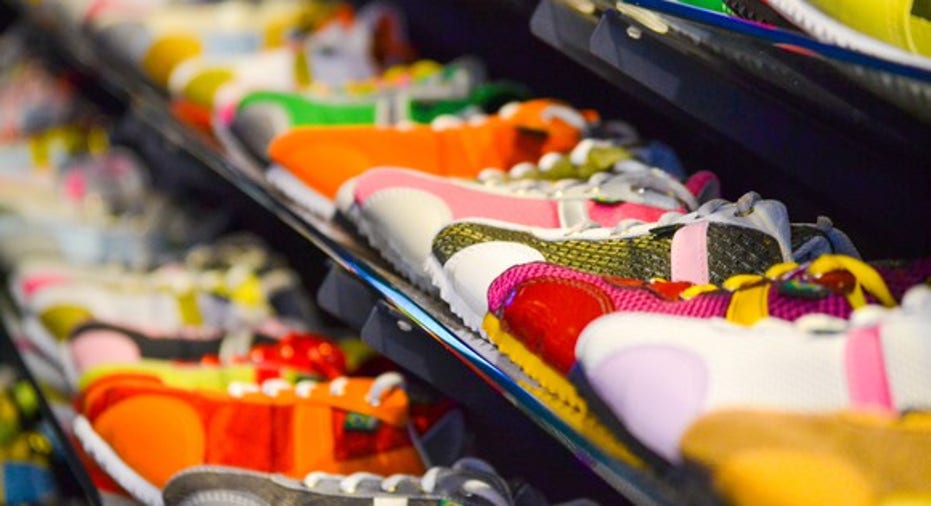3 Smart Ways Skechers USA Inc Is Investing in the Future

Image source: Getty Images.
Up until its most recently reported quarter, Skechers (NYSE: SKX) had been delivering phenomenal top line growth ranging from 18% to 32% over the past several years.In the second quarter, revenue increased a disappointing 9.6% over last year, the company's slowest pace in quite some time.Revenue growth typically starts to slow as a company grows in size, but Skechers is focused on three key areas to continue delivering those double-digit gains.
Reaching the masses
Skechers has worked hard to build its brand image and carve out a niche in the competitive footwear market. It used to be considered more of a knock-off brand, but the company has developed its own performance lines and unique products that can compete with the biggest competitors, includingNike, Adidas, and Under Armour. Last year, Skechers had 5% market share in the United States footwear market and surpassed Adidas to become the No. 2 brand (Nike continued to dominate with 62% market share).
During the second quarter conference call, CFO and COO David Weinberg said, "Our goal is to continue to develop innovative footwear and remain top of mind and drive purchase intent globally through a 360-degree approach to marketing."Ongoing marketing campaigns will allow the brand to reach new customers and promote its growing product assortment.
Skechers relies heavily on television and print advertising to promote its products, as well as a diverse group of brand ambassadors, including award-winning musicians Demi Lovato and Meghan Trainor, model and TV personality Brooke Burke-Charvet, and athletes like Sugar Ray Leonard and Howie Long.Several of its ambassadors competed this summer at the Rio Olympics in Skechers performance gear, including marathon runner Meb Keflezighi and golfer Matt Kuchar.
Retail expansion
Besides marketing, Skechers continues to expand its retail footprint by opening new stores domestically and internationally with three store formats: concept, factory outlet, and warehouse outlets. Concept stores go in high-traffic street locations, major tourist areas, and key shopping malls in metropolitan cities, playing an important role in Skechers' operating strategy.
First, the concept stores showcase the brand's entire product line. This is important since Skechers estimates its average wholesale customer carries no more than 5% of the complete Skechers line at any one location. Second, the locations are strategically chosen to maximize exposure to consumers -- think areas like Times Square, the Grand Canal Shoppes at The Venetian, Powell Street in San Francisco, and the recently opened One World Trade Center mall. Finally, the company uses its concept stores as marketing and product testing venues. Factory and warehouse outlet stores play another role in the supply chain -- moving discontinued and excess merchandise at higher margins than selling to discounters at excessively low prices.
Skechers opened 143 stores in the second quarter, bringing its total store count to 1,548, with 1,144 of its locations located outside the United States. It expects to have more than 1,600 stores by the end of the year, made up of a combination of company-owned and international joint venture locations.The joint venture expansion strategy has helped Skechers successfully enter and expand rapidly into new markets by leveraging locals who are familiar with operating retail businesses in their respective countries. Using joint ventures can also help mitigate potential risks, especially when expanding into unproven markets.
Gaining wholesale shelf space
The company's domestic wholesale business suffered in the second quarter, with U.S. wholesale net sales decreasing 5.4% year-over-year to $320.4 million, as a result of a significant pull forward of orders into the first quarter and a challenging promotional retail environment.Skechers lost some of its wholesale accounts in recent quarters when The Sports Authority closed, and Vestis Retail Group, the parent company of Bob's Stores and Sport Chalet, declared Chapter 11 bankruptcy. Bob's Stores will continue to operate after being sold to Versa Capital, but Sport Chalet closed all its stores last quarter and halted online sales.
Despite the challenging domestic wholesale environment, international wholesale net sales in the second quarter continued to deliver strong growth and increased 25.5% to $303.4 million.Wholesale continues to be a large opportunity to drive business growth for the company, and it is focused on increasing domestic and international wholesale accounts and the amount of shelf space dedicated to its products in its existing accounts. Weinberg expects domestic wholesale sales to grow in the low to mid single-digits and international wholesale as much as 30% to 40% in the back half of the year.
Investors will be keeping an eye on revenue growth in the third quarter when the company usually sees a significant sales boost thanks to back-to-school shopping. Once Skechers reports third quarter earnings, investors will have a better idea if these three strategies are paying off, and whether or not last quarter's single-digit revenue growth was just an anomaly or the new standard.
A secret billion-dollar stock opportunity The world's biggest tech company forgot to show you something, but a few Wall Street analysts and the Fool didn't miss a beat: There's a small company that's powering their brand-new gadgets and the coming revolution in technology. And we think its stock price has nearly unlimited room to run for early in-the-know investors! To be one of them, just click here.
Ben Estep has no position in any stocks mentioned. The Motley Fool owns shares of and recommends Nike, Skechers, and Under Armour (A Shares). Try any of our Foolish newsletter services free for 30 days. We Fools may not all hold the same opinions, but we all believe that considering a diverse range of insights makes us better investors. The Motley Fool has a disclosure policy.